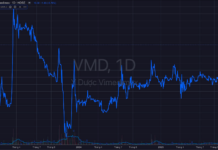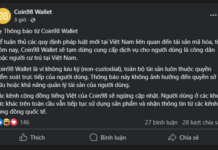Askonomy, also known as the “Economic Information Assistant” Askonomy, has launched a new version at the National Press Society 2024 event. Askonomy was developed by Vietnam Economic Magazine/VnEconomy in collaboration with partner Actable AI.
Data security and accuracy are major concerns for many organizations when it comes to AI chatbots. Mr. Tran Hoai Van, COO of Actable AI and partner in the development of Askonomy, shared how Askonomy addresses this issue through a conversation with Vietnam Economic Magazine/VnEconomy.
VIETNAM’S AI CHATBOT MARKET IS NOT BEHIND THE WORLD
Firstly, how do you evaluate the global and Vietnamese AI chatbot market?
From a technological perspective, chatbots have been around since the early days of computers, when computers were capable of interacting with and assisting users. However, the perception of chatbots has recently changed. Chatbots are now seen as tools that users use to receive information through text-based conversations. And now a second generation of chatbots is emerging, which in my opinion are intelligent virtual assistants.
Therefore, the flexible interaction capabilities of chatbots with humans are improving. Although there are still limitations, chatbots today have become much more “human-like”. From a technical and professional perspective, we see that chatbots have undergone a development process from traditional models that used rigid scripts and communication, to larger language models that can choose words and images more flexibly. Currently, chatbots have become smarter and known as virtual assistants, with large LLM language models that can handle diverse languages.
From a market perspective, let’s evaluate the supply and demand of chatbots. In the initial stage when chatbots first appeared, people were very interested in and used them a lot. However, they later found that chatbots had many limitations and did not meet their real needs, leading to a decrease in usage and sometimes forgetting the existence of chatbots.
However, with the emergence of ChatGPT, things have changed. With this large language model, the return of chatbot usage has become a very attractive trend and everyone can feel it. If there is demand, there will be supply; the more demand, the more supply, and the more diverse the demand, the more diverse the supply.
From the perspective of the domestic and international markets, I believe there are many similarities. Although Vietnam may lag behind the international market to some extent, with the Internet in a flat world, it has become simple for a product or technology to penetrate a country, especially Vietnam, where Internet development is considered very attractive.

According to you, should Vietnam develop chatbots for a large user base or focus only on specialized products?
Let the market decide on the scale of chatbot development. From my perspective, chatbots can serve many aspects of life. There are aspects that only serve a small number of users, but there will also be large-scale demands from society. And we can divide them into two models, “2C” and “2B,” both of which have opportunities to develop in Vietnam.
While “2B” focuses on specialized fields and niches, “2C” aims at mass accessibility for everyone, but each region and province has its own characteristics, requiring different data processing and information. Therefore, the investment and development opportunities for both models in Vietnam are still vast, serving both niche and mass markets.
ASKONOMY ENSURES SECURITY AND OUTPUT RESULTS WITH RELIABLE DATA SOURCES
Well, as you mentioned, Vietnamese businesses have many opportunities to participate in the chatbot market. So what challenges will they face in chatbot business?
In terms of supply, I am sure there will be a lot of supply, meaning many businesses will join the market because of the booming demand. However, in the process of development, I see two main limitations. The first is data, and the second is investment capital. For chatbots to develop and become user-friendly, with accurate answers and valuable information, they need accurate and updated data. Even this data needs to be designed to best meet the output requirements.
In terms of data, until now, in Vietnam and in general, data is a major issue for businesses and the country as a whole. Data is fragmented and not really “clean” at the moment, creating barriers to chatbot development.
The second barrier is the investment cost and maintenance of an effective language model. In addition, costs for infrastructure, personnel, construction, and maintenance can be burdensome for organizations and businesses, including the government. Even large chatbot models in the world require billions of dollars for deployment.
However, the cost may not be a major concern. Because developing a language model similar to ChatGPT and directly competing with ChatGPT can impose significant financial resource requirements. But the cost pressure will be greatly reduced when businesses developing chatbots focus on mass adoption and serving domestic needs, mainly in Vietnamese and step-by-step.
Moreover, the investment capital market has a global scope. Therefore, the important thing is for businesses to have an efficient business model that meets market demand and the ability to penetrate new markets. In that case, investment capital will no longer be a significant issue.
Do you have any thoughts on the security issues of AI chatbots?
I am not an expert in security, but I can see that in the field of artificial intelligence, security is a new form of knowledge, new to the world. That means that in addition to AI being an information technology machine, it requires traditional security measures. AI is also specifically related to input data, the training process, and the input data preparation for the model.
In this process, many security issues can arise, leading to a deviation in the output results of AI. Hackers can also interfere with the data, affecting the accuracy of AI. This is a specific security risk of AI virtual assistants. Therefore, the output results may violate two vulnerabilities that we are very concerned about: violations of ethical standards and violations of the law.
In addition, an important aspect of AI is the input data for the model, usually text or voice requests from users. The specific nature of language in this input makes the connection process with data sources and models unique, which can create security vulnerabilities or misinformation. Addressing this issue requires expertise in AI security to ensure that questions and ideas fed into the AI model are processed accurately and safely. If this process is not carried out correctly, the results may be distorted, resulting in inaccurate answers from AI.

As you are a COO of Actable AI, a partner company in the production of Askonomy, can you share with VnEconomy readers about the security solutions of Askonomy?
In the process of research and development of Askonomy, we always emphasize security, especially focusing on the use of standard and verified data sources from the beginning. The data used by Askonomy is taken from VnEconomy’s exclusive data source, as well as from legitimate data sources permitted to be exploited by government agencies. With such data sources, we believe that the output results of Askonomy are reliable.
In addition to obtaining accurate and clean data from quality sources, we also pay attention to regular data updates. This will ensure that the results of Askonomy meet the requirements of the demanding market we care about, which is people who understand the economy and those who want to learn about economic information, including experts and businesspeople. These user groups have high knowledge and evaluation skills regarding economic data and information, and they also have high requirements for the accuracy and completeness of the input data and output answers. Therefore, we hope that the accuracy and quality of the data on Askonomy will gradually meet their needs. This is also a strength of Askonomy.
ASKONOMY’S VIRTUAL ASSISTANT BRINGS A COMPLETELY NEW WAY OF READING NEWS
So it can be seen that Askonomy has solved a major challenge of security and accuracy of information, which is a major limitation of AI chatbots, thanks to reliable and regularly updated data sources. Askonomy is an “economic information assistant” targeting a specific user group. Regarding the business aspect, how does Actable AI plan to approach and attract potential customers to use Askonomy?
In addition to the strengths of Askonomy that I mentioned earlier, I also have another perspective, that is our breakthrough in the media market. In the past, readers only read newspapers to get information, but with Askonomy, they can participate in conversations, exchange information in a very natural way, which is very close to their needs. This helps them access information more easily and efficiently.
My perspective shows that we are developing a completely new media product, truly a breakthrough in the media industry. This difference is a natural and attractive communication material, with the ability to spread and go viral very well. Clearly, from reading paper newspapers to online newspapers and reading on mobile phones, the experience of reading news in this new way with Askonomy will have special appeal for generations who love market information updates. If we know how to use this product in a communication strategy, I believe this will be an extremely attractive and effective market approach.
The second aspect is that with a reputable media agency like VnEconomy, I believe that VnEconomy already has a significant loyal reader base. We bring Askonomy to these loyal readers and allow them to experience the new product, which will help expand the market. I believe that VnEconomy and the development team will find accurate and quick customer access solutions for Askonomy and VnEconomy in the new stage. The goal is to create loyalty, expansion, and ensure quality, which many other media organizations also desire.

So, I understand that using Askonomy is like a new method of reading news, a more proactive way of reading for readers. Instead of just reading in a traditional way, such as newspapers, online newspapers, or on mobile phones, readers can now decide on the content they want to read and search for specific information according to their needs. They also have the opportunity to access related and more detailed articles. In other words, they read news in a more active way rather than just accessing an online newspaper and reading the available articles. In summary, readers will have a flexible and personalized reading experience that matches their individual needs, is that correct?
That’s right. Meeting user needs is very important, especially in the current internet environment where information reading needs to be “fast and convenient”. It is precisely because of “fast and convenient” that people often say that we are being spammed with information and getting lost in it when searching for information.
With Askonomy, having a conversation instead of reading articles is an effective solution. Users don’t need to read multiple different articles like when using search tools. Askonomy provides quick and accurate aggregated information through conversations. In the future, Askonomy will further enhance conversations by allowing users to communicate through voice, enhancing the experience and helping users receive information quickly and accurately. I believe that this will be an interesting experience in the near future.




































